Programming Material Intelligence Using Food Waste Deposition to Trigger Automatic Three-Dimensional Formation Response in Bioplastics
“More than a substance, plastic is the very idea of its infinite transformation; as its everyday name indicates, it is ubiquity made visible. And it is this, in fact, which makes it a miraculous substance: a miracle is always a sudden transformation of nature. Plastic remains impregnated throughout with this wonder: it is less a thing than a trace of movement. – Roland Barthes
One of the main aims of the [DMIC] Digital Matter Intelligent Construction Research Studio is to investigate the possibility of employing adaptive architecture. During the ‘Space Dynamics’ workshop led by Manuel Kretzer, we were introduced to the material: Bio-plastic. Unlike plastics derived from fossil fuels, bio-plastic is made from organic compounds, and therefore can be part of the full life-cycle design, also known as the “Cradle-to-cradle” approach.
We were curious to learn more about Bio-plastic, since there are numerous advantages of this material, including the following: – Paramentric Material
– Affordable
– Accessible
– Lightweight
– Non-toxic
– Rigid / Flexible
– Transperent
– Heat Responsive
– Designer / Maker can control
– Biodegradable
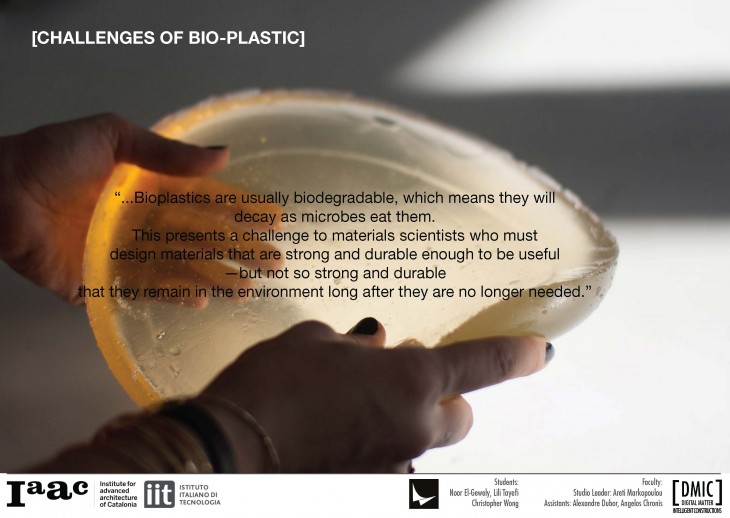
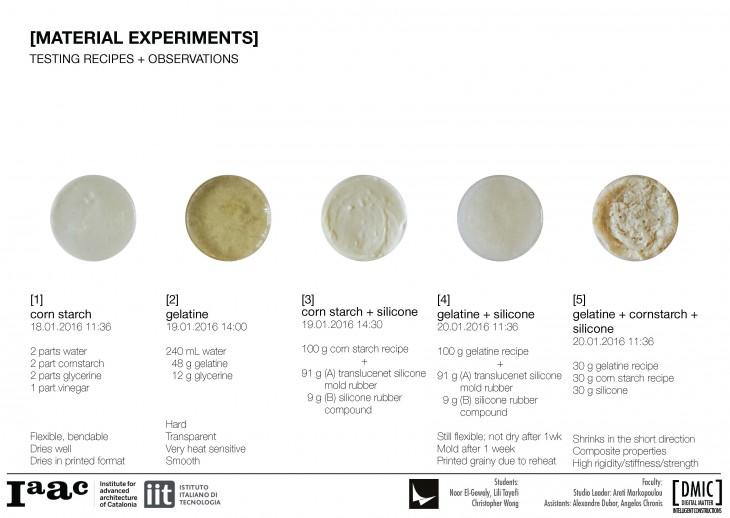
In our early material experiments we were testing various recipes to form our substratum material. Due to its desirable mechanical properties, we proceeded to work with a gelatine based bio-plastic.
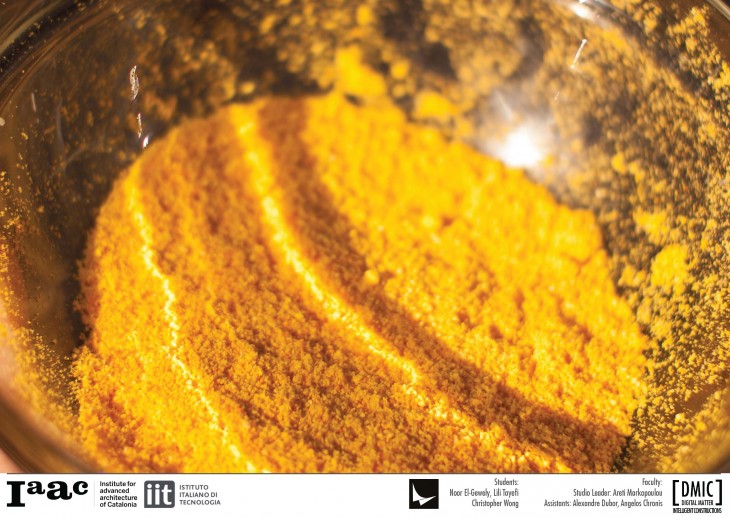
In order to fully take advantage of working with a biodegradable material, and the ethos of reducing, reusing and recycling, we began investigating how we could incorporate food-waste into our bio-plastic. Food-waste is generally perceived as unwanted matter, unless used for compost.
Our aim was to incorporate local food waste from our urban environment, and local context, in order to divert this matter from ending up in landfill. Some of the local produce that initially came to mind was: Orange Peel and Shrimp Peel. Spain is famous for its oranges, and Barcelona for its seafood. In addition to merely up-cycling food-waste, the organic matter would actually provide added beneficial properties to the bio-plastic.
Orange peel contains cellulose, which is an important structural component of the primary cell walls of green plants. It also happens to be the most abundant organic polymer on Earth. Cellulose has a high molecular chain length, or degree of polymerization. This high chain length relates to high tensile strength. Compared to starch, cellulose is more crystalline, meaning it can take higher temperatures before becoming amorphous in water.
We performed a series of material experiments on our bio-plastic to understand how and to what degree the material would transform when subjected to various strains and stresses.
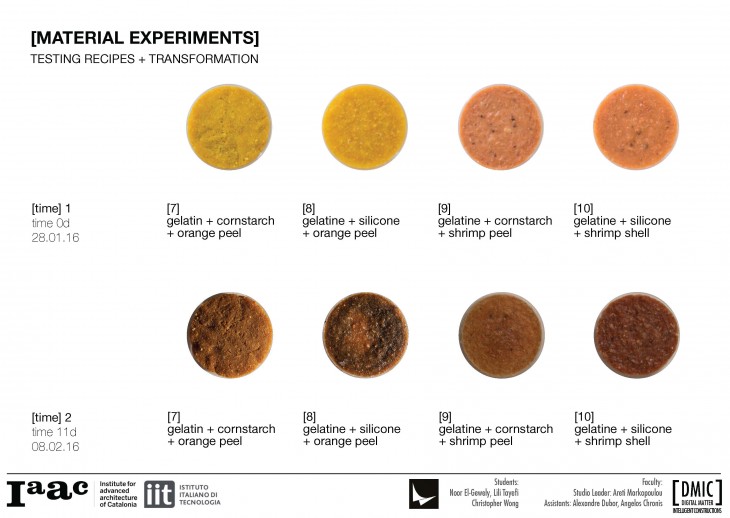
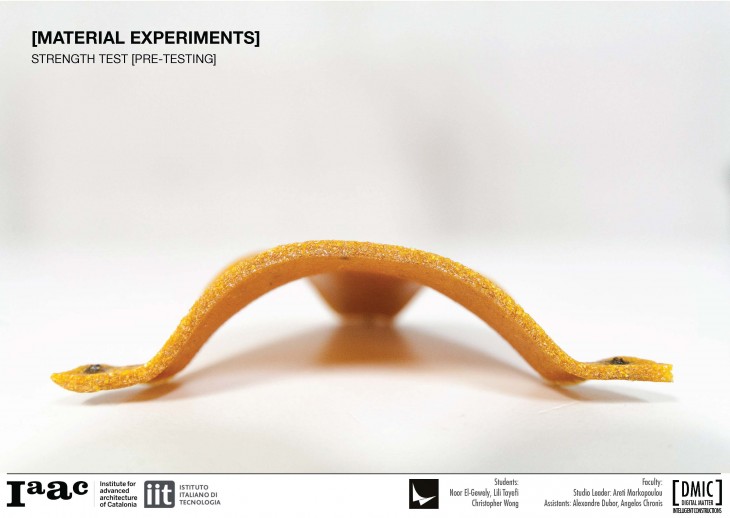
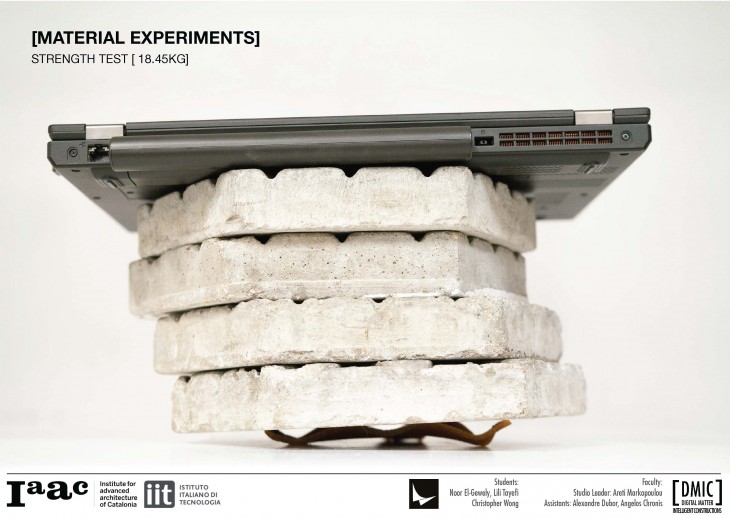
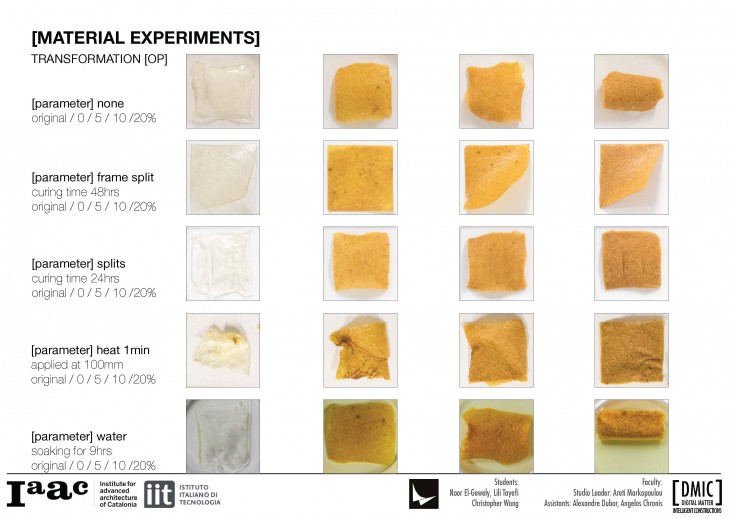
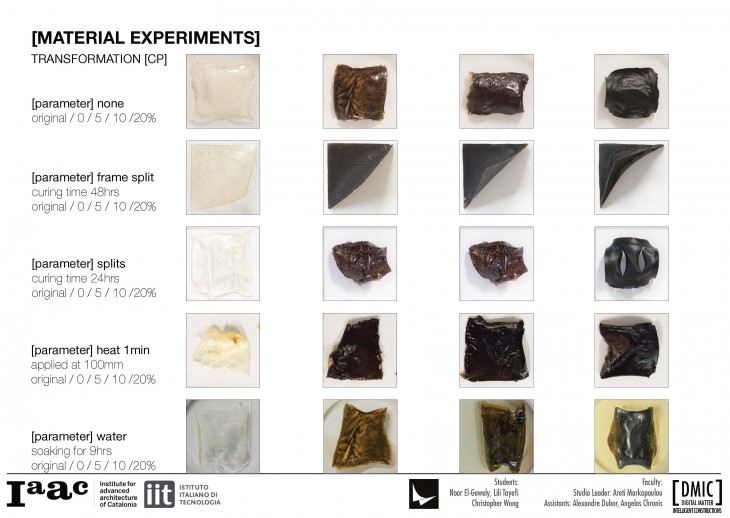
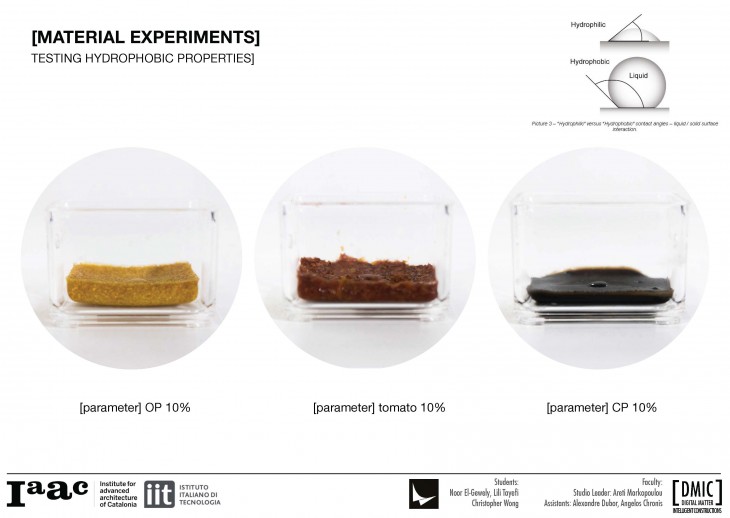
Some of the lessons learned from our material experiments we learned the Orange peel bio-plastic had improved strength, and higher heat-resistance. While the coffee powder bio-plastic was more hydrophobic.
Another observation that applied to both types of the bio-plastic was, their shrinkage and bend over time. The higher percentage of food-waste we used in the material, the more the material would bend on its own. The input of dehydrating the material would trigger an output of a self-assembly behaviour of the form. This was most dramatic in the coffee based bio-plastic.
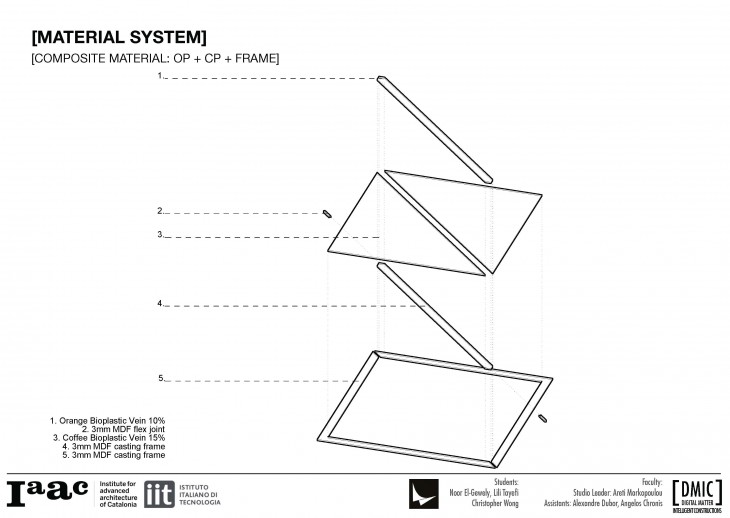
Moving forward, we wanted to develop a material system that combines the different characteristics of both the Orange and Coffee based bio-plastic in order to create a composite material.
- How could we begin to control the resultant behaviour of the material based on the geometry and location of the various food-wastes in the composite?
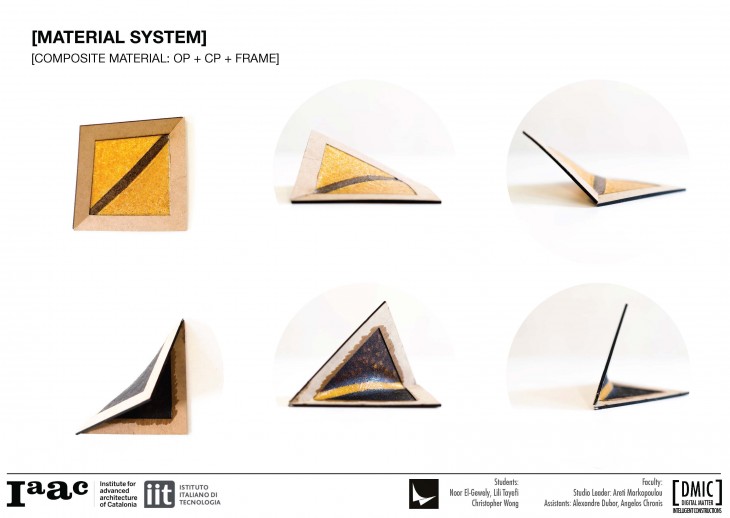
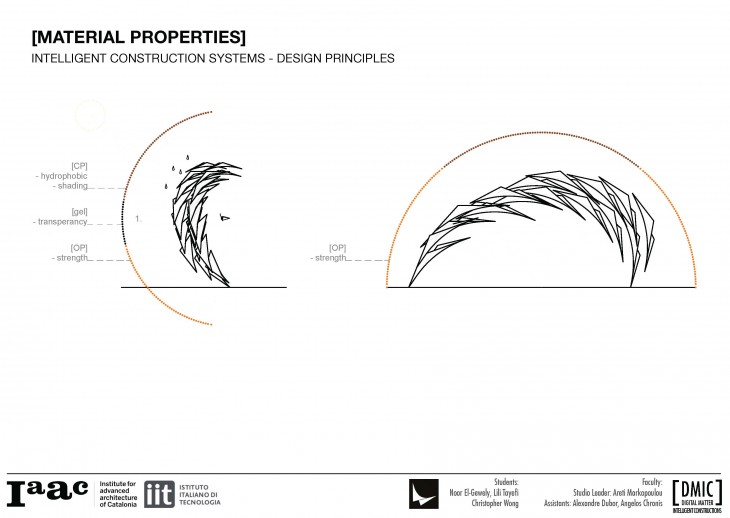
From a design perspective there are different properties that the various types of bio-plastic offer us, based on what type of food-waste we incorporate into it. Due to the ease of production and accessibility of this material, we can tailor the desired parameters to suit, based on our requirements for each project, but also to fine-tune the material performance within any given structure or object.
Although we have chosen to experiment with coffee and orange thus far, we do anticipate that this bio-plastic can be locally re-appropriated to incorporate food-waste which is most abundant at a given geographical location.
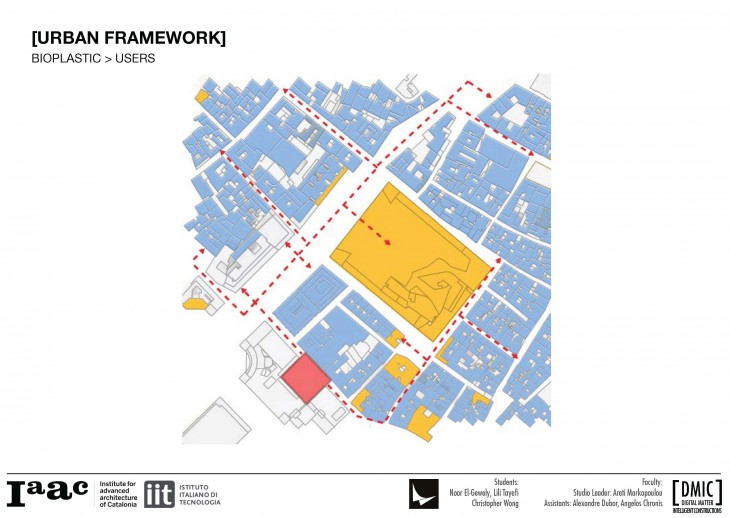
At this stage in the project we are investigating on how we can incorporate the material system of Piel Vivo into our urban cityscape, and participate in the food production and energy cycle of the city. We envision a strategy for the city of the future, where each neighbourhood could have a hub (Shown in Red) to collect food-waste from its surrounding, Food-sources (Yellow) and Residents (Blue). At the food-waste hub the matter is collected and sorted, and the bio-plastic is processed here. The bio-plastic can be made on-demand based on the user requirements, and go directly back for distribution to its local community, reducing the need for transportation.
Our objective for this research is to create an ephemeral architecture with an embedded material intelligence, using low-cost, local materials, which responds to its environment and its users based on their changing needs in contemporary society.
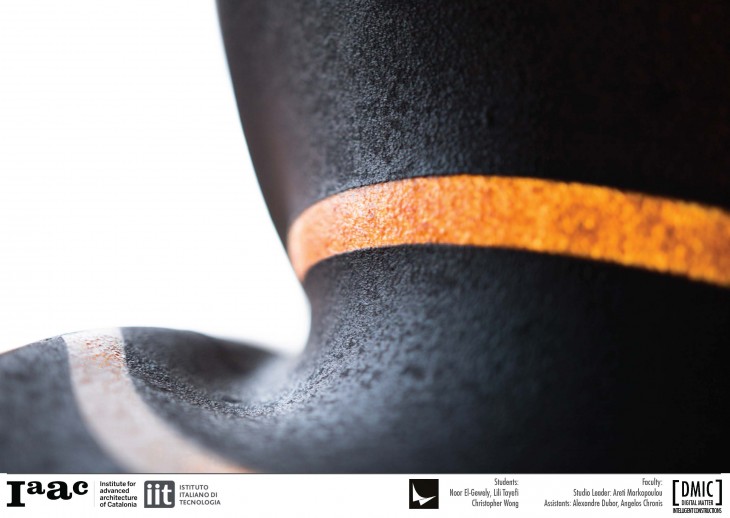
In order to adjust the viscosity of our material, we isolated each component of the recipe and varied
them one by one, to determine which would influence the result. The factors we tested were – reducing
water, increasing gelatin, increasing foodwaste, and adding starch.
We found that increasing the food waste content had the most successful eff ect. Therefore we proceeded
to test various percentages of food waste for both the orange peel and coffee bioplastic. The viscosity of the material was also proportional to the diameter of the nozzle size.
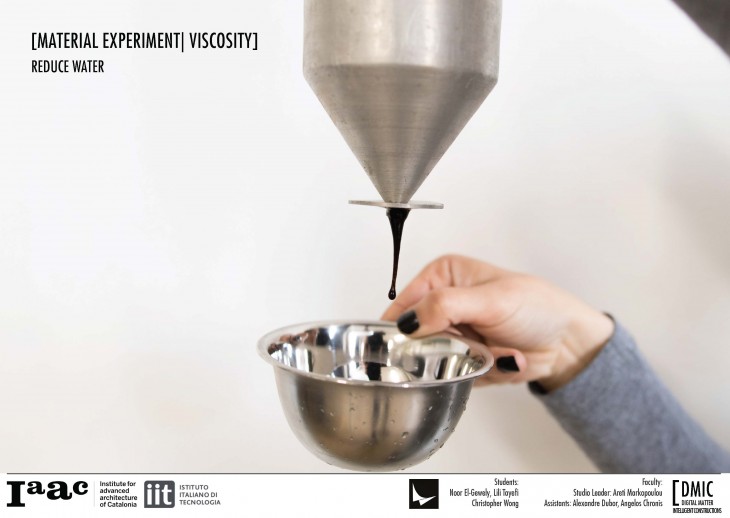
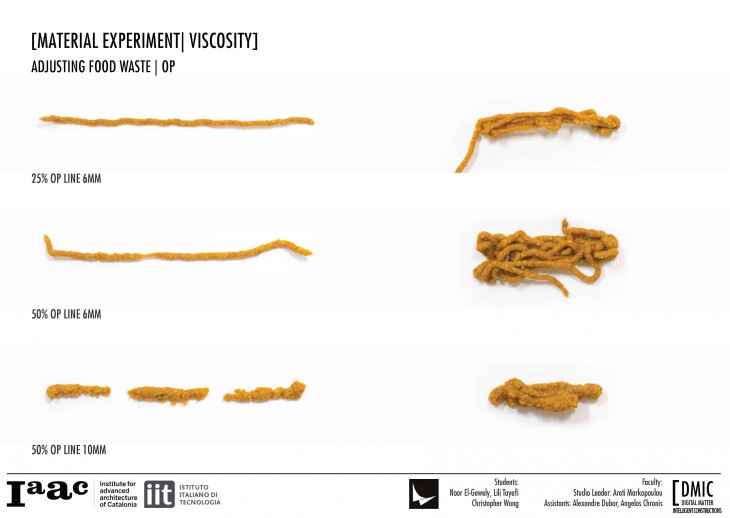
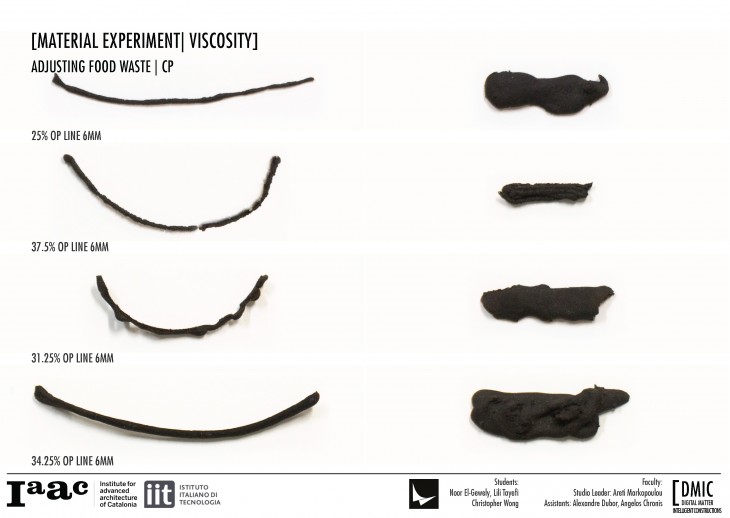
Another important factor that we adressed at this stage of the project was the material uniformity. The
less uniform a material is , the more difficult it is to print. In order to improve the material uniformity we needed to reduce the granular size of the orange peel. This was done by two steps: a better food processor, and dehydrating the OP in the oven before processing it.

There are several parameters to control when it comes to additive manufacturing such as – viscosity,
nozzle diameter, temperature, air pressure, height above printing surface. All the factors mentioned such as – viscosity, nozzle diameter, temperature, air pressure, height above printing surface, are directly linked to the scale used. Consequently for each item that we had resolved, it had to be re-calibrated as we moved up in scale. A lesson for future reference is to fi rst decide what is the scale of the object to be 3D printed – food, art
or construction, then tailor the fabrication method to suit.


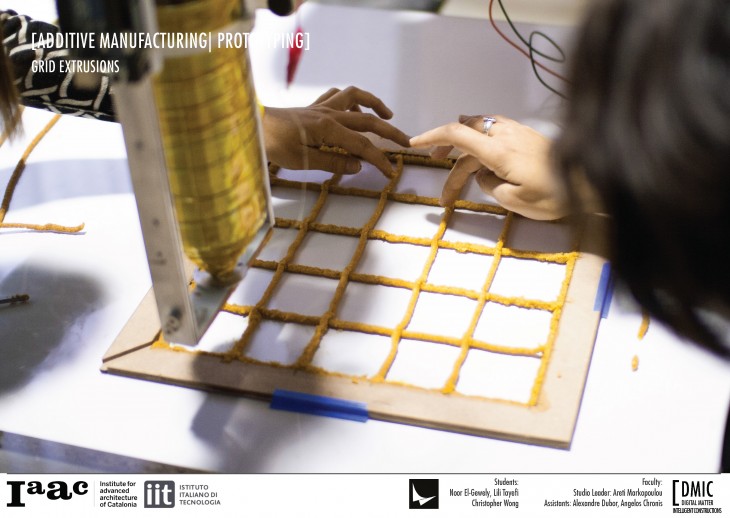
The logic of the user interface was based on the material system of the folding composite panels of the
bioplastic. In our material investigation we learned that by increasing the percentage of food waste
in the bioplastic, we could increase the degree of folding that was actuated. The Grasshopper plug in Kangaroo was used as an interactive physics solver, which would simulate and optimize the folding behaviour based on the input constraints.
The user could input the available dimensions of their site, and how many panels they wanted to divide the structure into. One of the other parameters that could be input was the desired degrees of folding needed. Part of the Grasshopper code generated would provide the resultant rest lengths of the geometry, to ease the fabrication process for the designer and user.

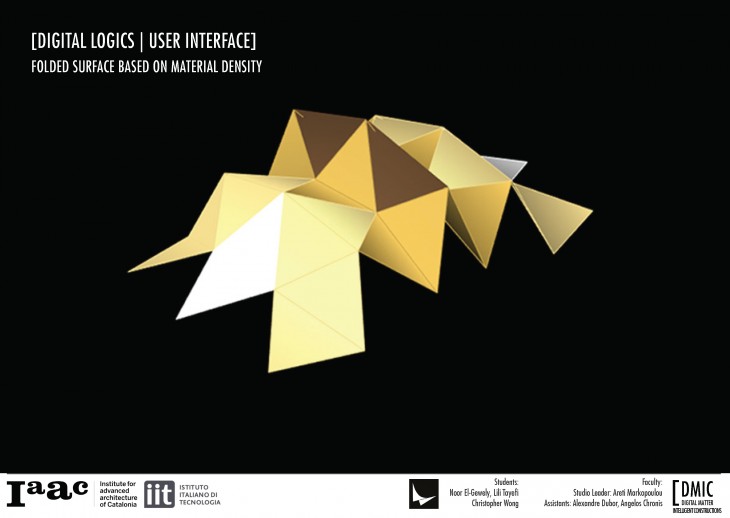
Based on the global geometry generated in the previous formfi nding excersice, this could then be
analyzed using the parametric structural engineering tool Karamba. This tool is embedded in the design environment of Grasshopper. The inputs of Karamba include; global geometry of the shell/mesh structure, types of applied loads, support points, material, beams, cross sections thickness. From this input we can gain information about the force flows within the structure, displacement, utilization, peak stress points.
Karamba can display this data visually and create an immediate feedback loop to inform the designer where in the structure failure is likely to occur or where the structure is being under utilized, so potentially material could be removed from. In our particular design, the load case was a hanging structure where the maximum stress was concentrated around the top support points. Since we had this knowledge we could make an
informed decision to have a higher density of food waste in those panels – given that we know that a higher content of cellulose would improve the structural performance of the bioplastic.
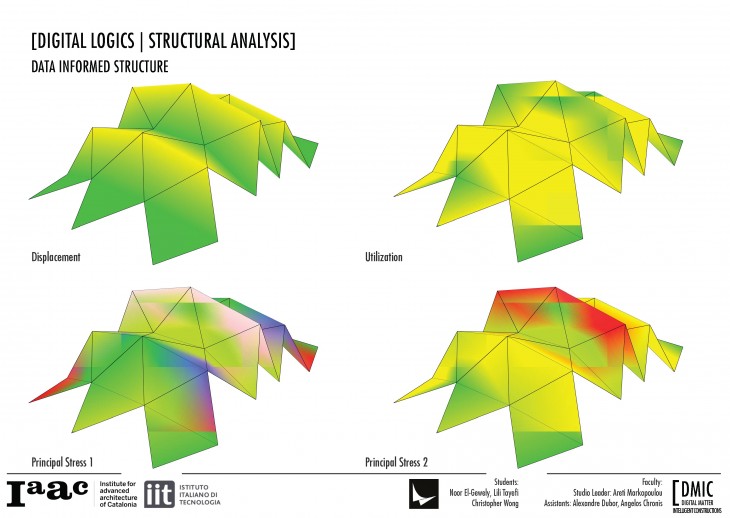
Our obiective was to vary the material deposition between the orange peel and coff ee bioplastic in a gradient across the overall structure. Therefore each panel had a differential amount of the types of food
waste embedded in them.
In addition to the system of composite panels we were creating, another challenge of our material investigation was to demonstrate that we could develop a material that was able to be 3D printed vertically.
Due to the unique self-forming properties of the bioplastic, we wanted to work with this quality in mind when creating the vertical toolpaths. Therefore we intentionally designed weaknesses into the structure, that would act as a point of flextion. The geometry of the 3D printed object would transform over time as
a result of the curing process.

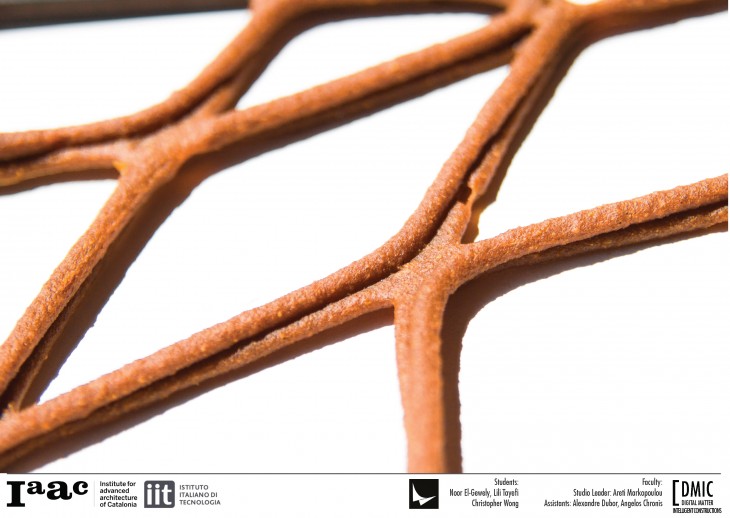
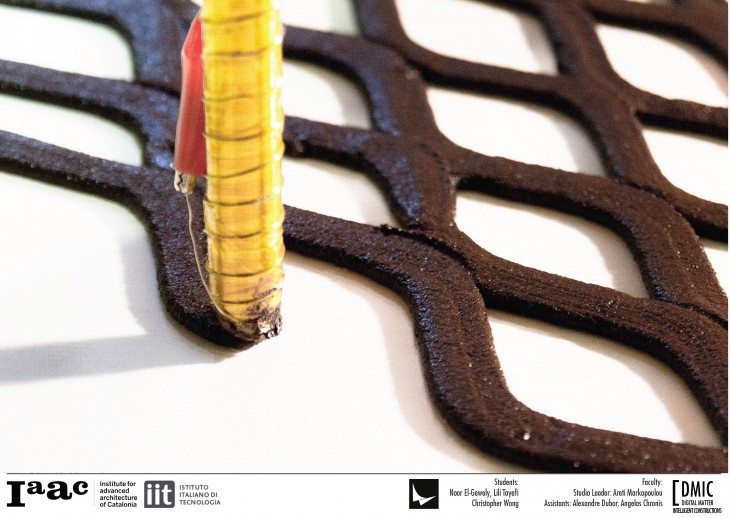
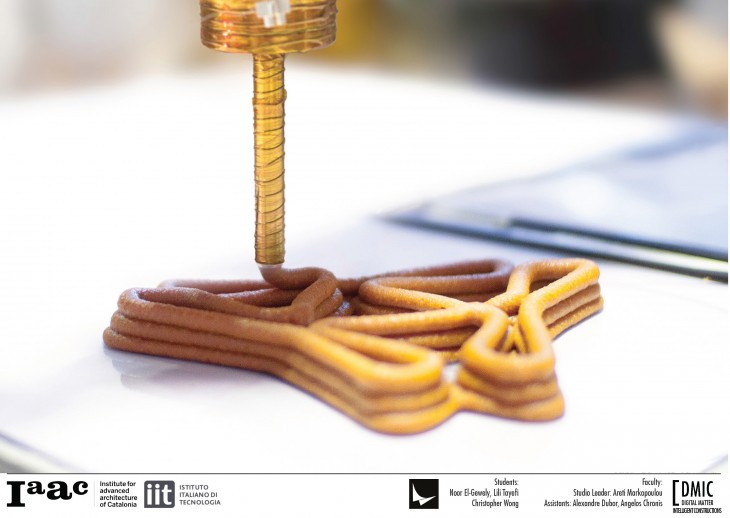
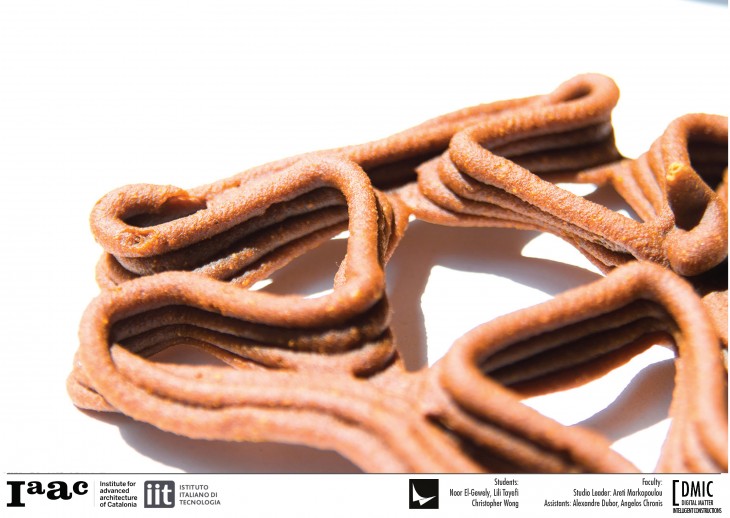
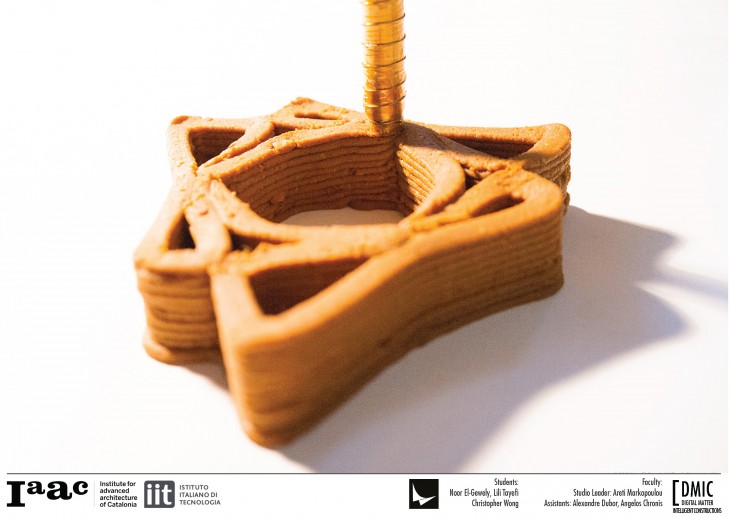
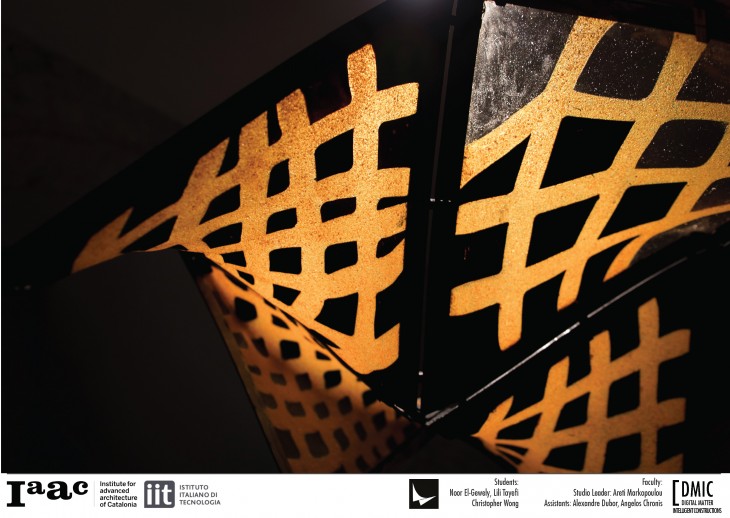
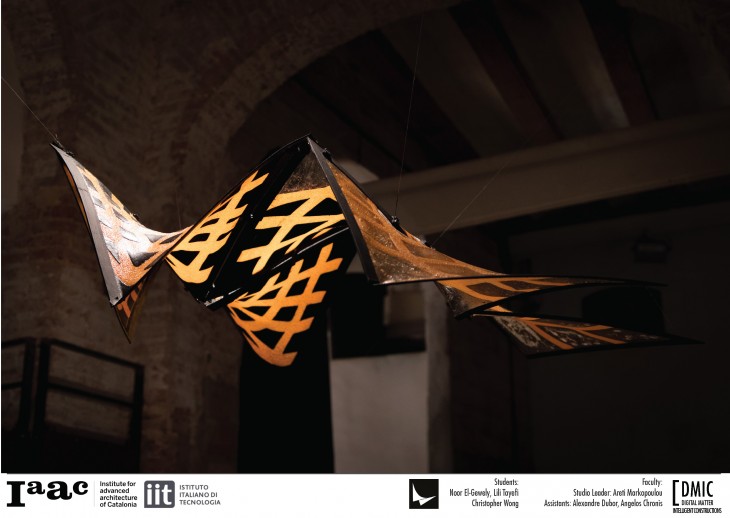
PIEL VIVO/BIO-PLASTICA – Material Explorations is a project of IaaC, Institute for Advanced Architecture of Catalonia, developed at Master in Advanced Architecture in 2015/2016 by:
Students: Noor El-Gewely, Lili Tayefi, Christopher Wong
Faculty: Areti Markopoulou, Alexandre Dubor, Angelos Chronis
With help from:
Space Dynamics Workshop:Manuel Kretzer
Material Science Support: Athanassia Athanassiou, Ilker Bayer
Robotic Fabrication Expert: Djordje Stanojevic
Additive Manufacturing Expert: Sofoklis Giannakopoulous
Computational Expert: Rodrigo Aguirre
Physical Computing Expert: Angel Muñoz
References:
http://www.nomads.usp.br/virus/virus06/?sec=7&item=2&lang=en
http://www.archdaily.com/137993/aia-pavilion-gernot-riether
http://www.arch2o.com/2011-aia-pavilion-gernot-riether/
http://www.dusarchitects.com/projects.php?categorieid=publicbuildings&projectid=europebuilding
http://aasarchitecture.com/2014/07/research-pavilion-2013-14-icd-itke.html
http://www.european-bioplastics.org/
https://en.wikipedia.org/wiki/Cellulose
http://www.tandfonline.com/doi/pdf/10.1080/15583724.2013.834933
https://www.reddit.com/r/AskEngineers/comments/28jptj/would_a_hydrophobic_coating_
http://www-materials.eng.cam.ac.uk/mpsite/properties/non-IE/stiff
http://www.grasshopper3d.com/group/kangaroo
http://www.karamba3d.com/
http://www.robotsinarchitecture.org/kuka-prc
http://www.in3dustry.com/en/home
http://nomadcoff
